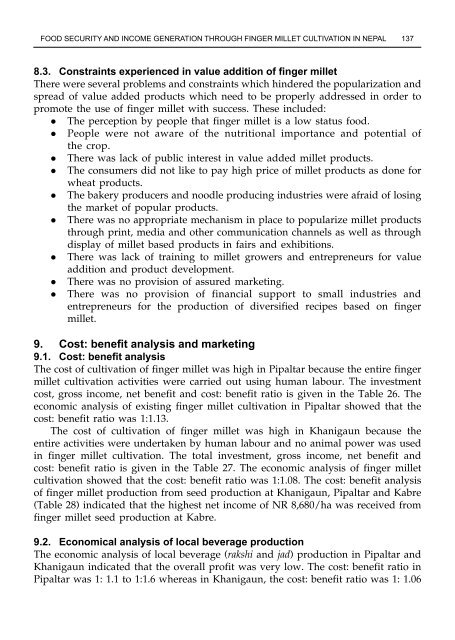Minor millets in South Asia: learnings from IFAD-NUS project in India ...
Minor millets in South Asia: learnings from IFAD-NUS project in India ...
Minor millets in South Asia: learnings from IFAD-NUS project in India ...
Create successful ePaper yourself
Turn your PDF publications into a flip-book with our unique Google optimized e-Paper software.
Food seCuritY and <strong>in</strong>Come generation through F<strong>in</strong>ger millet CultiVation <strong>in</strong> nepal 137<br />
8.3. Constra<strong>in</strong>ts experienced <strong>in</strong> value addition of f<strong>in</strong>ger millet<br />
There were several problems and constra<strong>in</strong>ts which h<strong>in</strong>dered the popularization and<br />
spread of value added products which need to be properly addressed <strong>in</strong> order to<br />
promote the use of f<strong>in</strong>ger millet with success. These <strong>in</strong>cluded:<br />
The perception by people that f<strong>in</strong>ger millet is a low status food.<br />
People were not aware of the nutritional importance and potential of<br />
the crop.<br />
There was lack of public <strong>in</strong>terest <strong>in</strong> value added millet products.<br />
The consumers did not like to pay high price of millet products as done for<br />
wheat products.<br />
The bakery producers and noodle produc<strong>in</strong>g <strong>in</strong>dustries were afraid of los<strong>in</strong>g<br />
the market of popular products.<br />
There was no appropriate mechanism <strong>in</strong> place to popularize millet products<br />
through pr<strong>in</strong>t, media and other communication channels as well as through<br />
display of millet based products <strong>in</strong> fairs and exhibitions.<br />
There was lack of tra<strong>in</strong><strong>in</strong>g to millet growers and entrepreneurs for value<br />
addition and product development.<br />
There was no provision of assured market<strong>in</strong>g.<br />
There was no provision of f<strong>in</strong>ancial support to small <strong>in</strong>dustries and<br />
entrepreneurs for the production of diversified recipes based on f<strong>in</strong>ger<br />
millet.<br />
9. Cost: benefit analysis and market<strong>in</strong>g<br />
9.1. Cost: benefit analysis<br />
The cost of cultivation of f<strong>in</strong>ger millet was high <strong>in</strong> Pipaltar because the entire f<strong>in</strong>ger<br />
millet cultivation activities were carried out us<strong>in</strong>g human labour. The <strong>in</strong>vestment<br />
cost, gross <strong>in</strong>come, net benefit and cost: benefit ratio is given <strong>in</strong> the Table 26. The<br />
economic analysis of exist<strong>in</strong>g f<strong>in</strong>ger millet cultivation <strong>in</strong> Pipaltar showed that the<br />
cost: benefit ratio was 1:1.13.<br />
The cost of cultivation of f<strong>in</strong>ger millet was high <strong>in</strong> Khanigaun because the<br />
entire activities were undertaken by human labour and no animal power was used<br />
<strong>in</strong> f<strong>in</strong>ger millet cultivation. The total <strong>in</strong>vestment, gross <strong>in</strong>come, net benefit and<br />
cost: benefit ratio is given <strong>in</strong> the Table 27. The economic analysis of f<strong>in</strong>ger millet<br />
cultivation showed that the cost: benefit ratio was 1:1.08. The cost: benefit analysis<br />
of f<strong>in</strong>ger millet production <strong>from</strong> seed production at Khanigaun, Pipaltar and Kabre<br />
(Table 28) <strong>in</strong>dicated that the highest net <strong>in</strong>come of NR 8,680/ha was received <strong>from</strong><br />
f<strong>in</strong>ger millet seed production at Kabre.<br />
9.2. Economical analysis of local beverage production<br />
The economic analysis of local beverage (rakshi and jad) production <strong>in</strong> Pipaltar and<br />
Khanigaun <strong>in</strong>dicated that the overall profit was very low. The cost: benefit ratio <strong>in</strong><br />
Pipaltar was 1: 1.1 to 1:1.6 whereas <strong>in</strong> Khanigaun, the cost: benefit ratio was 1: 1.06

















